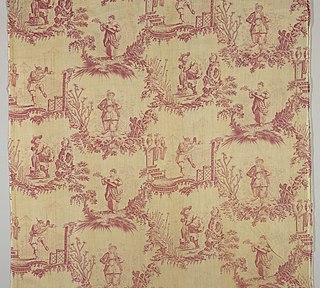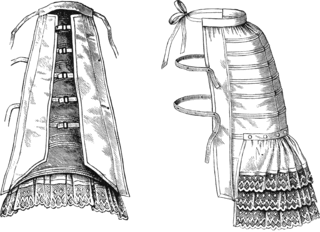Related Research Articles

Textile is an umbrella term that includes various fiber-based materials, including fibers, yarns, filaments, threads, different fabric types, etc. At first, the word "textiles" only referred to woven fabrics. However, weaving is not the only manufacturing method, and many other methods were later developed to form textile structures based on their intended use. Knitting and non-woven are other popular types of fabric manufacturing. In the contemporary world, textiles satisfy the material needs for versatile applications, from simple daily clothing to bulletproof jackets, spacesuits, and doctor's gowns.

Muslin is a cotton fabric of plain weave. It is made in a wide range of weights from delicate sheers to coarse sheeting. It is commonly believed that it gets its name from the city of Mosul, Iraq.

Chintz is a woodblock printed, painted, stained or glazed calico textile that originated in Golconda in the 16th century. The cloth is printed with designs featuring flowers and other patterns in different colours, typically on a light, plain background.

Percale is a closely woven plain-weave fabric often used for bed covers. Percale has a thread count of about 180 or higher and is noticeably tighter than twill or sateen. It has medium weight, is firm and smooth with no gloss, and washes very well. It is made from both carded and combed yarns, and may be woven of various fibers, such as cotton, polyester, or various blends.

Dimity is a collective term for figured cloths of harness loom decorated with designs and patterns. It is a strong cotton cloth with various stripes and illustrations. It is bleached or washed after looming, less often dyed, unlike fustian, which is usually dyed.

Broadcloth is a dense, plain woven cloth, historically made of wool. The defining characteristic of broadcloth is not its finished width but the fact that it was woven much wider and then heavily milled in order to shrink it to the required width. The effect of the milling process is to draw the yarns much closer together than could be achieved in the loom and allow the individual fibres of the wool to bind together in a felting process, which results in a dense, blind face cloth with a stiff drape which is highly weather-resistant, hard wearing and capable of taking a cut edge without the need for being hemmed.
Bafta is a kind of calico, initially made in India.

Sussi or susi is a term for multicolored striped or checked cloth produced mainly in Sindh. Sussi is thin handloom fabric made of cotton, silk, or a blend of the two, with colored warp stripes. Sindh region was known for its production and exports during the Mughal period. Sussi was most often made with red and blue, blue and white, or green and white stripes, but other patterns were also produced. The fabric was exported to England, where sousaes were in great demand in the 18th century.

Piece goods were the textile materials sold in cut pieces as per the buyer's specification. The piece goods were either cut from a fabric roll or produced with a certain length, also called yard goods. Various textiles such as cotton, wool, silk, etc., were traded in terms of piece goods. The prices were determined as per the fabric quality.
Alacha is a lightweight striped cloth made primarily of silk, sometimes cotton, or a mixture of both. The stripe pattern was evident on both sides of the fabric. A typical length of alacha is five yards. It was produced in various parts of India, for example Baikunthpur, Bihar. The cloth was popular in use for female garments such as dupattas (odhni), veils, and petticoats.
Salampore (salempore) was a kind of cotton cloth produced in India. It had been in use since the 17th century and was exported to Europe and Africa.
Seerhand muslin (Seerhand) was a plain weave thin cotton fabric produced in the Indian subcontinent.
Balzarine (Balzorine) was a cotton and worsted fabric of the 19th century. It was a lightweight union cloth made of cotton and wool.
Sinchaw, or Synchaw, was a silk type described in an early 19th century list of prices as “a firm thick even Kind of Goods”. Sinchaw was among the varieties of Chinese silk imported into the United States during the eighteenth century. The length of a piece was around 30 yards with a variance of one yard.
Cherryderry was a blended fabric with silk warp and cotton weft, typically with a stripe or check pattern.
Harateen or harrateen was a woolen material of the 18th and early 19th-century produced in England. It was a furnishing material with a pattern used in upholstery.
Diaper is a damask cloth with small geometrical patterns such as bird's eye or diamond shapes. Terms such as “bird’s eye” or “pheasant’s eye” refer to the size of the diamond in the design. Diaper has been used as a tablecloth.
Alamode (Allamod) was a thin, soft, fine, and lustrous silk material. It was one of England's local silk varieties. However, it was recognized as ''Alamode'' in the early 17th century before it was famous for its use in scarves.
Sannas was a cotton cloth from the 17th century. This fabric was plain weave cotton, which was produced in the Indian state of Orissa. After 1640, huge quantities of Sannas were exported to Europe. Sannas, Cassas, and Bafta were among the Indian textiles exported for shirting and sheeting uses. Sanna was mostly white or blue in colour.
A blend is a mixture of two or more fibers. In yarn spinning, different compositions, lengths, diameters, or colors may be combined to create a blend. Blended textiles are fabrics or yarns produced with a combination of two or more types of different fibers, or yarns to obtain desired traits and aesthetics. Blending is possible at various stages of textile manufacturing. The term, blend, refers to spun fibers or a fabric composed of such fibers. There are several synonymous terms: a combination yarn is made up of two strands of different fibers twisted together to form a ply; a mixture or mixed cloth refers to blended cloths in which different types of yarns are used in warp and weft sides.
References
- 1 2 Foster, William (1906). The English Factories in India. Clarendon Press. p. 62.
- 1 2 Tortora, Phyllis G.; Johnson, Ingrid (2013-09-17). The Fairchild Books Dictionary of Textiles. A&C Black. p. 610. ISBN 978-1-60901-535-0.
- ↑ Montgomery, Florence M. (1984). Textiles in America 1650-1870 : a dictionary based on original documents, prints and paintings, commercial records, American merchants' papers, shopkeepers' advertisements, and pattern books with original swatches of cloth. Internet Archive. New York; London : Norton. p. 361. ISBN 978-0-393-01703-8.
- ↑ Wellington, Donald C. (2006). French East India Companies: A Historical Account and Record of Trade. Hamilton Books. p. 227. ISBN 978-0-7618-3475-5.
- ↑ Hardstaff, R. E. (2004). Human Cargo: And the Southwell Connection : a Record of a Slave Trading Voyage of the Eighteenth Century and the Links with People Living in the Southwell Area at that Time. Southwell and District Local History Society. p. 36. ISBN 978-0-9520503-2-2.